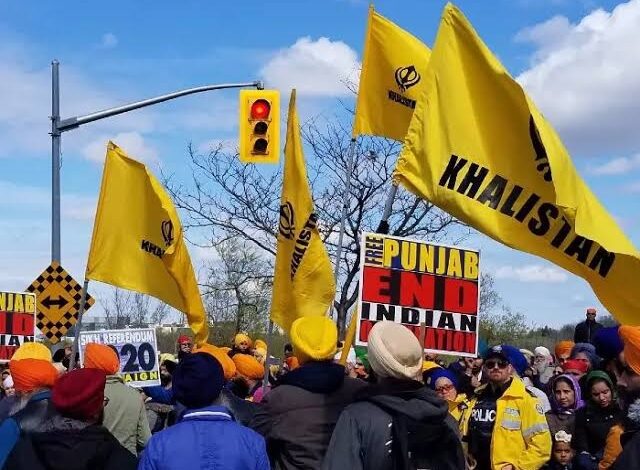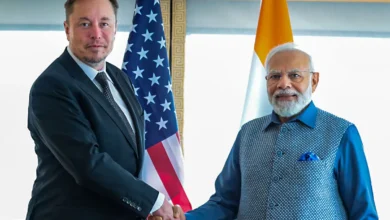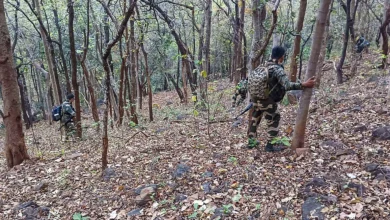Khalistan: Advent of a novel, aimless and treacherous terrorism
The rising menace of the Khalistani terrorists that taint the Khalsa Pant and the gospel of Guru Granth Sahib have to be history's most lost rebels without a cause. Their movement goes against the essence of Sikhism and the Vani (Holy word) of the Gurus.

The Khalistanis ask for separation of Punjab to put it simply, but the movement is the most lost among many separatist attempts made through the history of modern ‘Akhand Bharat’. How can Khalistani terrorists take ISI aid to ask for Indian Punjab when majority of Punjab is still in Pakistan?
The Nanakana Massacre (birthplace of Guru Nanak Dev Ji) in Pakistan by Islamists has been conveniently forgotten as the these self-proclaimed Sikhs have allied with them for ammunition. What will they do with this Punjab with water-logged farms, declining GDP and high dependence on other states for several resources? How will the Patna Sahib pilgrimage take place when animosity with India will not facilitate any possibility of a religious corridor? Have they forgotten that Maharaja Ranjit Singh’s flag had Maa Bhairavi on it? or that his currency coins had Hindu Gods on it?
Guru Gobind Singh ji, the tenth Sikh Guru had formed the Panch Pyare, have they forgotten they were Hindus? Have they forgotten when Guru Gobind Singh ji said, “Sakal Jagat Mein Khalsa Panth Gaaje, Jage Dharma Hindu Turak Dhundh Baaje”?
Those who have heard Pannun’s speeches more than they have read the Gurus are to dictate the Sikh needs? As prodigal as this movement is, it has taken over the minds of Indians either by periodic events of the Indian flag’s disrespect or Canada’s historic infamous blind eye to Khalistani crime for their Prime Minister’s lust for vote-banks or inflaming statements from terror leaders.
Hence, it is necessary to understand the origin, the ’cause’ and the support that has established what we know today as the ‘Khalistani Movement’.
History
In Punjab and other regions of Northern India, extreme separatists led a murderous campaign that began in the early 1980s to carve out an independent, theocratic Sikh state known as Khalistan (Land of the Pure).
The British colonial practices of the late 1800s and early 1900s, which tried to split Sikhs and Hindus, are the origins of Khalistan. To employ against Hindu tyrants who revolted against the British Raj, a considerable number of Sikhs were enlisted into the British army. Following Indian independence in 1947, tensions between the state of Punjab and the national government emerged, giving rise to complaints from a large number of Sikhs against the government.
For instance, Punjab was divided into the states of Punjab, Haryana, and Himachal Pradesh in 1966 along linguistic lines (Punjab is a Punjabi-speaking state, while Haryana and Himachal Pradesh are Hindi-speaking states). This caused resentment among many Sikhs because it meant that Punjab’s historical borders, which had already been split between India and Pakistan in 1947, were being further divided. Given the predominately Hindu populations of Haryana and Himachal Pradesh, it is interesting to note that it was the subsequent separation of Punjab that allowed Sikhs to enjoy a religious majority in the state.
Many Sikhs in Punjab also objected to Haryana and Punjab’s shared ownership of Chandigarh, and they saw water-sharing arrangements as unjust and benefitting Haryana’s farmers at the expense of Punjab’s. Additionally, Sikh religious leaders demanded more governmental authority for Punjab because they were concerned about the group losing its identity and culture.
Although these kinds of disagreements frequently characterize state-federal relations in recently independent nations like India, many Sikhs saw them as the result of religiously motivated policies that discriminated against them. Radical leaders took advantage of this perception to propagate the idea that Sikh interests would only be secure in an independent Sikh country called Khalistan. An “incendiary mix of unprincipled politics and the manipulation of religious identities and institutions” that elevated radical Sikh groups to the forefront of politics in the province of Punjab only served to exacerbate the situation.
The Khalistan movement is seen as having started in April 1978 with violent battles between radicalized Sikh organizations led by Jarnail Singh Bhindranwale and the Nirankari sect (which was viewed as heretical by the former). And in 1980, Bhindranwale and his allies began murdering Hindus, including Lala Jagat Narain, the editor of the dialect weekly Punjab Kesri and a strident opponent of Bhindranwale. Large-scale violence against people spread throughout the state soon after this.
The violent campaign of the Khalistan movement, which reached its height in the 1980s and 1990s, featured bombings, assassinations, kidnappings, and killings of people. Nearly 22,000 people, both Sikhs and Hindus, including about 12,000 civilians, died as a result of the movement. When Canadian-based Khalistani separatists detonated a bomb on an Air India aircraft traveling from Toronto to New Delhi in 1985, all 329 passengers on board—including 82 children under the age of 13—were killed. This act gave the violence a worldwide scope. The terrorist assault that killed the most people in Canadian history was that one.
Human Rights Watch states that during the bloody separatist struggle for an independent Khalistan, “Militants were responsible for numerous human rights abuses, including the killing of Hindu and Sikh civilians, the assassination of political leaders, and the indiscriminate use of bombs leading to a large number of civilian deaths in Punjab and other parts of India.” Criminals started to intimidate businesspeople and landowners while posing as militants and demanding protection money.
The Khalistan movement deteriorated into thuggery over time:
According to Canadian political science professor Hamish Telford, “The Khalistan movement deteriorated into thuggery over time. The extremists increased their use of robbery, extortion, rape, random executions, and terrorist assaults on defenseless civilians. By 1991, most people considered Sikh militants to be dishonest criminal groups.
Indian security forces and the local Punjab police used force in reaction to the movement and in an effort to put an end to militancy in the region, sometimes violating human rights. Additionally, by eroding democratic institutions, meddling in elections, failing to appropriately handle local/state concerns, and failing to maintain good ties between the state and the central government, the Congress Party-led central government added to the state’s troubles. The bulk of the police, security personnel, and politicians in Punjab were and are Sikh, it is vital to emphasize. In actuality, KPS Gill, the police captain credited with putting a stop to the rebellion in Khalistan, is a Sikh. Additionally, extremists killed Sikh politicians including former Chief Minister Beant Singh.
Violence Against Civilians of Punjab
Most of the innocent Sikhs who died as a result of the militant violence were slain by separatists for supporting the Khalistan movement. For instance, almost 70% of the casualties of terrorist attacks in 1990–1991 were Sikh civilians. Further, terrorist attacks on Mazhabi Sikhs—also known as lower caste Sikhs in Punjab—were common.
In order to stir up racial tensions and drive Hindus from Punjab out of fear, Hindus were also targeted in large numbers. Along with widespread violence, terrorists frequently posted posters in villages warning Hindus to leave and threatening Sikhs who tried to assist Hindus. As a result, many of Hindus in Punjab were forced to leave their homes and seek safety in Delhi and nearby regions.
May 1985 saw at least 86 persons killed when Khalistani terrorists detonated more than 30 explosives over the course of 14 hours at bus and train terminals, as well as public parks in New Delhi and the states of Punjab, Haryana, Rajasthan, and Uttar Pradesh. Here’s a chronology of notable assaults.
December 1986 saw the slaughter of 24 Hindu passengers on a bus by militants at Khuda in the Hoshiarpur district, along with seven additional injuries. Similar events occurred four months earlier when terrorists ordered all the Sikh passengers off a bus in Muktsar, leading to the death of 15 Hindu passengers.
In the Hoshiarpur area in March 1988, militants opened fire on villagers who were enjoying the Hindu holiday of Holi, killing 32 Hindus and injuring another 25. The same evening, 12 more Hindus were slain in separate instances.
In June 1989, terrorists shot and killed two Sikh bus passengers for interfering and attempting to save the lives of Hindu passengers.
At Thapar Engineering College in Patiala, India, in November 1989, terrorists murdered 19 students while they slept in a hostel.
On two trains in June 1991, gunmen from the Khalistan Commando Force slaughtered 125 people, including women, men, and children. When the first train came to a stop close to the city of Baddowal, gunmen fired indiscriminately at it. Nearby, militants halted a second train, separated the Sikh and Hindu passengers, and ordered the Hindus off the train before executing them.
M.L. Manchanda, the director of the All India Radio station in Patiala, was abducted and beheaded by Babbar Khalsa militants in May 1992 for disobeying a directive to exclusively broadcast in Punjabi. Manchanda’s deceased body was left with his head in Ambala and his torso in Patiala.
Attacks on voters in Punjab’s statewide elections were another target of the violent Khalistan movement’s campaign.
Hinduphobia as Pillar of Terrorism
Virulent anti-Hindu rhetoric and propaganda that stigmatized and threatened the state’s minority Hindu community as well as promoted and applauded violence against Hindu civilians were there alongside the horrifying bloodshed in Punjab. This was a component of militants under the leadership of Bhindranwale’s attempt to sabotage the state’s social fabric and foment divides between Hindus and Sikhs, two groups that had previously enjoyed cordial ties, common religious practices, and a history of intermarriage.
In order to terrify Hindus, who revere cows as holy animals, the Dal Khalsa, which earned prominence for hijacking an Indian Airlines jet in 1981, erected severed cow heads at many Hindu temples in the state.
Similarly, on July 28, 1984, Babbar Khalsa International (BKI) leader Ajaib Singh Bagri said at a public gathering in Canada, “I give you my most solemn assurance that until we kill 50,000 Hindus, we will not rest!” The cries of “Hindu dogs!” were in response from the throng of thousands of pro-Khalistan protesters. “Death to them!”
The US Department of State later labeled BKI and the International Sikh Youth Federation as Specially labeled Global Terrorist (SDGT) organizations in accordance with section 1(b) of Executive Order (E.O.) 13224.
International Patronage of Khalistani Separatism
The Inter-Services Intelligence (ISI) Agency of Pakistan, as well as pro-Khalistan separatists stationed in the United States, Canada, and the United Kingdom, have all provided financial and logistical assistance to the Khalistan movement throughout both of its heydays.
In particular, the ISI spy agency in Pakistan, according to Indian defense analyst Ajai Sahni, “coordinated their activities with Islamist terrorist organizations such as the Lashkar-e-Toiba and the Hizb-ul-Mujahideen, as well as with organized crime operators, and drug and weapons smugglers who have assisted in the movement of men and materials across the border into Punjab.”
Furthermore, “[t]he involvement of the diaspora was an important dimension of the Sikh insurgency,” says international policy specialist Christine Fair. It not only provided diplomatic and financial backing, but it also made it possible for Pakistan to participate in stoking Sikh separatist aspirations. Sikhs in Canada, the UK, and the US were crucial in helping to organize the cadres’ passage to Pakistan, where they received financial and military support.
Supporters of Khalistan in the West have actively lobbied the governments of the United States, Canada, and the United Kingdom against India while raising money for the terrorist organizations operating in Khalistan. They frequently transfer money using unofficial hawala networks, which are frequently used by criminal and terrorist groups in South Asia.
The FBI, DEA, and United States Customs Service (USCS) have all conducted investigations into the pro-Khalistan radicals’ activities in the US.
For instance, in March 2017, US resident and Khalistan fanatic Balwinder Singh was found guilty of giving material support to terrorist organizations in India and given a 15-year term in federal prison. On “charges of conspiracy to provide material support to terrorists, conspiracy to murder or otherwise harm persons in a foreign country,” as well as for fabricating an asylum application, the FBI had detained him in 2013. Singh was helping BKI and another organization, Khalistan Zindabad Force, carry out terrorist attacks in India.
Bhajan Singh Bhinder, a Khalistan activist in California, was previously the target of an undercover USCS sting operation that revealed he tried to buy military-grade weapons, including “M-16s, A.K.-47s, detonators, night-vision goggles, mobile communications equipment, remote-control equipment, grenade and rocket launchers,” for Khalistan groups carrying out terror attacks in India. After Bhinder pulled out of the contract, the probe was subsequently halted. Since then, Bhinder has founded a number of additional groups, most notably the anti-India and anti-Hindu Organization for Minorities of India (OFMI).
Sikhs for Justice, another US-based organization, is the most well-known pro-Khalistan organization in the west and is rumored to have the ISI’s backing. Although it has acknowledged ties to terrorists jailed in Khalistan and people accused of being involved in extensive terror plans in India, it purports to peacefully seek for a referendum on Khalistan in 2020. For instance, it paid for Jagtar Singh Tara’s legal defense. Tara was the mastermind behind the 1995 murder of the Chief Minister of India’s Punjab state by the Khalistan Tiger Force, a group that India has labeled as a terrorist organization.
Gurpatwant Singh Pannun, SFJ’s legal adviser, and Paramjit Singh Pamma, a BKI fundraiser wanted by Indian authorities for financial support of terrorism, are also closely connected. According to reports, Mr. Pannun was detained by British authorities in 2000 after getting terrorist training in Pakistan. He was subsequently sentenced to 30 months in jail for his alleged affiliation with BKI, a terrorist organization that is illegal in the UK, but he disputes the claim.
Latest on Gurpatwant Singh Pannun – Sikhs for Justice Co-Founder
Gurpatwant Singh Pannu, a Khalistan separatist who India identified as a terrorist in 2020, has been the subject of a FIR in Ahmedabad for threats made against the city’s hosting of the ICC Cricket World Cup 2023, which is scheduled to start on October 5.
The leader of the outlawed organization “Sikhs for Justice” allegedly threatened multiple people via a pre-recorded voice message transmitted from a foreign number, according to the FIR filed by the cybercrime unit of the Ahmedabad police. According to reports, the threats were delivered in retaliation for the June murder of separatist from Khalistan Hardeep Singh Nijjar in Canada.
India classified Pannu as a “persona terrorista” on July 1, 2020.
The calls using the United Kingdom’s country code +44 that contained threats against the World Cup matches in Ahmedabad were made “to spread terror and rumors,” according to the FIR. According to a police officer, “Pannu’s voice” can be heard on the recordings of the calls. The murder of Nijjar, which has recently become a diplomatic hotspot between India and Canada, was threatened with a “storm Ahmedabad with Khalistan flag” to exact revenge.
Please, also have a look into : Khalistani terrorists recruit Punjabi youth by sponsoring visas for Canada: Intel report



